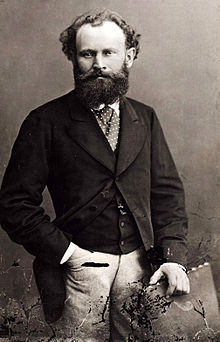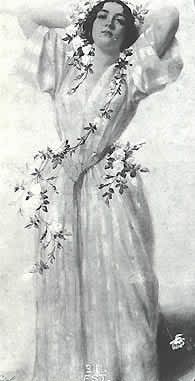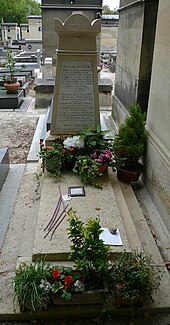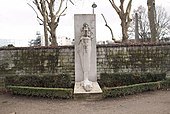Charles Baudelaire
Charles-Pierre Baudelaire [ ʃaʀl.pjɛʀ bodlɛʀ ] (born April 9, 1821 in Paris , † August 31, 1867 there ) was a French writer and one of the most important poets of the French language . He is best known for his collection of poems Les Fleurs du Mal and is considered an important pioneer of literary modernism in Europe .
Life and work
childhood
Charles Baudelaire (his name in literary history) was the only child from the late second marriage of the wealthy, art and literature-loving former administrative clerk Joseph-François Baudelaire (1759–1827) and his 34 years younger wife, Caroline Aupick, née Dufaÿs ( 1793–1871), who was born in London as the daughter of French emigrants, was orphaned at the age of seven and returned to France.
At the age of five he became a half-orphan through the death of his 67-year-old father. Additionally traumatized by the rapid remarriage of his mother with the authoritarian and ambitious officer Jacques Aupick and by moving from Paris to Lyon (1832) and back to Paris (1836), he developed into a difficult, often depressive, feeling unloved and rootless Boy who was deported to boarding schools and who was expelled from school for disobedience shortly before the Baccalauréat (Abitur).
youth
After he had passed the " bac " as an external in 1839 , he enrolled in law studies, which was supposed to serve as preparation for the diplomatic career his parents wanted. He saw himself as a budding writer, frequented circles of the Parisian literary and artistic bohemians and wrote poetry from 1838 at the latest. He also ran into debt, had a relationship with a prostitute and contracted syphilis .
At the urging of his mother and, above all, his stepfather, who had meanwhile become a general and was ashamed of the apparently ill-advised stepson, Baudelaire embarked on a voyage by ship in June 1841 that would take him to India and give him other thoughts. But he only drove as far as the islands of Mauritius and La Réunion in the Indian Ocean, where he spent a few weeks and was shaped by the tropical nature in his imagination and inspired to write poems.
The failing dandy
When he returned after a good eight months, he vowed his stepfather to get better; soon afterwards he joined the bohemian again. After reaching the age of majority in 1842, he demanded his share of the father's inheritance (an impressive 75,000 francs) and in 18 months squandered half of the inheritance through a luxurious dandy existence. He received active support from his new lover, the actress Jeanne Duval , whose exotic beauty he wrote. In 1844, the concerned family brought him under the legal guardianship of the notary Narcisse Ancelle (1801–1888), which offended him and perhaps contributed to a suicide attempt in 1845. The remainder of the inheritance guaranteed him a small pension from which a frugal individual could well have lived.
The writer
His writing, which he now tried to pursue more systematically and professionally, remained unprofitable. Sporadically he managed to put poems in magazines. In 1846 and 1847, also in magazines, his only slightly longer narrative texts were two short stories: the pretty love story Le jeune enchanteur (“The young enchanter”) and the (initially rejected and then more randomly printed) artist novella La Fanfarlo , which seems to reflect Baudelaire's metamorphosis from the poetic dandy to the almost bourgeois author and quasi-husband, witty coded and full of sparkling self-irony. The novella focuses on Baudelaire's love affair with his muse Jeanne Duval .
Some drafts for the dramas that he sketched between 1843 and 1854, including a play La Fin de Don Juan , remained a project, as did the many sketches for further prose. He found a certain recognition only with the reports on art exhibitions (salons), which he wrote from 1845 with increasing competence. Since he had got used to the consumption of hashish, opium and alcohol and also endured Jeanne Duval, he was constantly in need of money, which in turn increased his tendency to depression.
As a socialist and a revolutionary

During the social and political agitation of 1847, Baudelaire became a Fourier observance socialist . When the February Revolution broke out in 1848 , he was an enthusiastic revolutionary in the streets of Paris. He founded a short-lived left-wing magazine with two friends and was also otherwise active as a political publicist. At times he attended the discussion and action group Société républicaine centrale founded by Auguste Blanqui , the u. a. Théophile Silvestre and Fanny Lewald also belonged. On June uprising consisting of the national workshops dismissed workers of Paris, he participated in vorderster front. He felt increasingly frustrated with the subsequent gradual seizure of power by the conservative “Party of Order”, like so many committed young intellectuals. After participating in the brief and futile resistance against Louis Napoléon Bonaparte's coup d'état of December 2, 1851 , he withdrew to an existence as an apolitical writer who limited himself to being present on the Parisian literary scene with poetry, short prose, essays, author portraits and book reviews to be.
The translator EA Poes
As early as 1845 Baudelaire had transmitted one and in 1848 another story by the American narrator and poet Edgar Allan Poe (1809–1849), whom he felt as a kindred spirit. In 1856 he published a volume with stories by Poe and made it known to French readers in a lengthy foreword, which is considered an important contemporary source on the author. In 1858 he completed his Poe transmissions with the only novel Poes, Aventures d'Arthur Gordon Pym ( English The Narrative of Arthur Gordon Pym of Nantucket ).
Madame Sabatier
Although he was still in a relationship with Jeanne Duval, he adored Apollonie Sabatier in letters and poems sent anonymously to her from 1852 to 1858, a pretty, charming and witty woman who, as a well-to-do mistress of a banker, ran a salon in which many writers and Artists frequented. When Baudelaire's game of hide-and-seek came out and she gave herself to him, which he was reluctant to accept, he then confused her with the accusation that she had now become unsuitable as an ideal image and source of inspiration for poetry. Despite the disappointment, she remained on friendly terms with him.
Les Fleurs du Mal
In 1857, at the age of 36, Baudelaire published the work with which he was to go down in literary history: Les Fleurs du Mal ( The Flowers of Evil ), a collection of 100 poems that were written from around 1840 onwards, some of which had already been printed individually, but now, sorted by topic, tried to form a quasi-composed whole. The basic moods of these formally and linguistically sophisticated, mostly rather short poems are (as is often the case with the romantics) disillusionment, pessimism, melancholy; evoked reality appears (unlike the romantics) as predominantly ugly and morbid, man as torn between the powers of light and good ("l'idéal") and those of dark and evil, even Satan ("le whimsy "). One of the most important innovations of Baudelaire in the Fleurs is the - albeit sparingly - integration of the world of the big city into the lyric - a world that was generally presented as rather repulsive and gloomy, which, however, corresponded to the reality in the overpopulated, explosively growing and dirty Paris of the time .
The success was initially low. Six poems denounced as obscene or blasphemous by a star critic in Paris brought the author and his publisher Auguste Poulet-Malassis to a criminal case in July 1857 for “insulting public morality”. On August 20, 1857, Baudelaire was sentenced for this. The six poems objected to "because of obscene and immoral passages" were therefore omitted when a second edition of the Fleurs appeared in 1861, increased by 35 new poems . The third, expanded edition, published posthumously in 1868, contained them again.
The world of the city is often the subject of the lyric prose texts that Baudelaire wrote from 1855 onwards. After they had only been printed scattered during his lifetime, they created a new literary genre, the poème en prose , when they were collected posthumously in 1869 as Le Spleen de Paris .
Baudelaire and Manet

In 1859 Baudelaire met Édouard Manet and was friends with him until his death. In 1862 Manet gave him a place in his painting Music in the Tuileries Garden . In the same year he also painted the portrait of Jeanne Duval. After Baudelaire's death, he made various etchings with his portrait and recorded his burial in the painting The Burial . In the posthumously published collection of poems Le Spleen de Paris , Baudelaire dedicated the story La Corde ( The Rope ) to Édouard Manet. In it, Baudelaire described the suicide of Manet's studio assistant Alexandre.
The last few years

Around 1860 Baudelaire had achieved a certain degree of fame in literary Paris and was valued by many colleagues, but his financial situation was worse than before, not least because he was now paying for the nursing home for Jeanne Duval, who was paralyzed from 1858. He therefore stayed frequently in Honfleur with his mother, who was widowed again in 1857.
In 1860 he too succumbed to the enthusiasm for Wagner , which was rampant in Paris, and he published a longer étude on Richard Wagner et Tannhäuser .
At the end of 1861 he decided to apply for a vacant seat in the Académie Française . His exploratory visits to some “Académiciens” were disappointing; Friends made him give up his candidacy.
The following years were marked by further financial and increasingly health problems as a result of his alcohol and drug consumption as well as the incurable syphilis at the time. In April 1864 he went to Brussels in the hope of being able to give lucrative lectures on French literature there and in other up-and-coming Belgian cities; however, there was no success. He spent almost two years (often sick, miserable and barely able to work) in Brussels; then he suffered a stroke. In July he was transferred to a Paris nursing home. There he lived, paralyzed on one side, unable to speak and looked after by his mother, for almost a year.
Baudelaire died in 1867 at the age of 46 in the Paris clinic of Dr. Duval in the Chaillot district (1 rue du Dôme, 16th arrondissement ). His funeral mass was celebrated on September 2, 1867 in the church of St. Honoré-d'Eylau ; he was buried in the Cimetière du Montparnasse .

meaning
For his direct contemporaries, that is, for the few readers who knew his name, Baudelaire was above all a competent writer of reports on art exhibitions, a good literary critic, a diligent translator of Poe, and a Wagner enthusiast and promoter. The following generation of poets, the symbolists (e.g. Verlaine , Mallarmé or Rimbaud ), he was considered an epoch-making model. Baudelaire himself never experienced this recognition.
For a long time Baudelaire has been the best represented French poet in anthologies and school reading books. His poetry also had an impact in other countries. In Germany she influenced, among others, Georg Trakl and Stefan George , from whom the first German transmission of the Fleurs du Mal comes.
Works
Publications during his lifetime (selection)
- 1856: Foreword Sa vie et ses oeuvres about: Edgar Allan Poe : Histoires Extraordinaires Calmann-Levy, Paris 1856. 2nd (new) edition, Levy Frères, Paris 1875, legible in Gallica in the scan. - German excerpt (from the 2nd chapter of the introduction): in EA Poe: The double murder in the Rue Morgue and other stories Emil Vollmer, Wiesbaden undated (1962), pp. 3-11; or in (longer edition): Gondrom, Bayreuth 1985 ISBN 3-8112-0422-X pp. 5-21; ibid. 2002: ISBN 3-8112-2127-2
- 1857: Les Fleurs du Mal - dt. The flowers of evil
- 1859: Théophile Gautier
- 1859: Essay Photography and the Modern Audience (In: Theory of Photography I )
- 1860: Les paradis artificiels, opium et haschisch Dt. The artificial paradises
- 1861: R. Wagner et Tannhauser à Paris
Publications posthumously (selection)
- 1869: Le Spleen de Paris / Spleen . Bilingual. Adaptation by Oskar Ansull . Afterword by Thomas A. Keck. Revonnah, Hannover 1995 ISBN 3-927715-22-0 ; New translation by Simon Werle , Rowohlt, Hamburg 2019, ISBN 978-3-498-00687-7
- 1868: Curiosités esthétiques
- Les Epaves in German: Strandgut Limes, Wiesbaden 1947
-
Œuvres complètes 1868–70 in 7 volumes, to which the souvenirs, correspondance etc. (1872) form a supplement. German by Max Bruns in 6 volumes, Verlag JCC Bruns, Minden 1903–1923
- in German, again: Melzer, Dreieich 1981. ISBN 3-8201-0062-8
- 1963: Tableaux Parisiens. (German) Translator & Afterword Walter Benjamin . Suhrkamp 1963
- 1977: All works / letters in eight volumes. Edited by Friedhelm Kemp and Claude Pichois in collaboration with Wolfgang Drost. Hanser publishing house .
- 2017: Les Fleurs du Mal - The Flowers of Evil: Poems. Newly translated by Simon Werle . Rowohlt, ISBN 978-3-498-00677-8 .
Charles Baudelaire as translator and editor of Edgar Allan Poe's works
- 1856: Le Corbeau , Paris
- 1856: Histoires extraordinaires
- 1857: Nouvelles histoires extraordinaires
- 1858: Les Aventures d'Arthur Gordon Pym . novel
- 1865: Histoires grotesques et sérieuses
- undated: Eureka
Since 2017, dtv has published a five-volume Edgar Allan Poe edition in a new translation by Andreas Nohl . It follows the edition published by Charles Baudelaire and contains his comments.
- Charles Baudelaire (Ed.): Edgar Allan Poe. Scary stories. dtv, Munich 2017, ISBN 978-3-423-28118-8 .
literature
- Walter Benjamin : Charles Baudelaire. A poet in the age of high capitalism . Suhrkamp, Frankfurt 1969, 1974. Edited and with an afterword by Rolf Tiedemann .
- Walter Benjamin: About some of Baudelaire's motifs. In: Ders .: Illuminations. Selected writings . Suhrkamp, Frankfurt 1977, ISBN 3-518-06845-8 , pp. 185-250 (in the version of the collected writings).
- Gudula Biedermann: Return to the magical-religious origins of language in Baudelaire, Mallarmé, Rimbaud and Claudel . In: German-French Institute Ludwigsburg (ed.): Germany - France. Ludwigsburg Contributions to the Problem of Franco-German Relations , Vol. 2 (= Publications of the German-French Institute Ludwigsburg eV Volume 2), Deutsche Verlags-Anstalt, Stuttgart 1957, pp. 180–188.
- Karl Heinz Bohrer : The farewell. Theory of mourning: Baudelaire, Goethe, Nietzsche, Benjamin . Suhrkamp, Frankfurt 1997, ISBN 3-518-40807-0 .
- Yves Charnet: Baudelaire. Grandes oeuvres, commentaires critiques, documents complémentaires. Balises series, Série Les écrivains, 2. Ernst Klett-Verlag , Stuttgart & Nathan, Paris 1992, ISBN 3-12-592542-8 & ISBN 2-09-180228-X (French).
- Frank Donner: Volupté, sois toujours ma pure! Polymorphic images of women in Charles Baudelaire “Fleurs du Mal” . Der Andere Verlag, Osnabrück 2002, ISBN 3-936231-98-2 .
- Jean Firges : Baudelaire, "The Flowers of Evil" (Series Exemplary Series Literature and Philosophy , Vol. 8). Sonnenberg, Annweiler 2001, ISBN 978-3-933264-15-2 .
- Bettina Full: Caricature and Poiesis. Charles Baudelaire's aesthetic. Winter, Heidelberg 2005, ISBN 3-8253-5147-5 .
- Théophile Gautier: Charles Baudelaire. His Life. European literature publisher Print on Demand , Bremen 2011, ISBN 978-3-86741-341-1 (English).
- Alexander Kupfer: Modern blasphemies of a moralist. Charles Baudelaire and the artificial paradises . In: Ders .: The artificial paradises. Intoxication and reality since romanticism. A manual . Metzler, Stuttgart 2006 (Düsseldorf, Univ., Diss., 1994), ISBN 3-476-02178-5 , pp. 563-593 and passim (first 1996: ISBN 3-476-01449-5 ).
- Wolfgang Matz: 1857: Flaubert, Baudelaire, founder . S. Fischer, Frankfurt 2007.
- Henning Mehnert: melancholy and inspiration. Conceptual and historical studies of the poetic “psychology” of Baudelaire, Flauberts and Mallarmé . Winter, Heidelberg 1978, ISBN 3-533-02611-6 .
- Jean-Paul Sartre Baudelaire . Rowohlt TB, Reinbek 1997, ISBN 3-499-14225-2 .
- Walther Skaupy, Great Trials of World History, Morality, Immorality and Religious Offenses in the Trials of the Poets Gustave Flaubert and Charles Baudelaire, pp. 98 ff, Magnus-Verlag, Essen
- Isabelle Viéville-Degeorges: Baudelaire: clandestin de lui-même . Page après page, Paris 2004, ISBN 2-84764-014-2 .
- Barbara Vinken : traces of characters, wording: Paris as a memory space. Hugo's “A l'Arc de Triomphe”, Baudelaire's “Le Cygne” . In: Anselm Haverkamp , Renate Lachmann (Ed.): Memory art. Space - image - writing. Studies in mnemonics . Suhrkamp, Frankfurt 1991 (es series, NF 653), ISBN 3-518-11653-3 , pp. 231-262.
- Winfried Wehle : Baudelaire: “Parfum exotique” . In: Hans Hinterhäuser (Ed.): Die Französische Lyrik , Volume 2. Düsseldorf 1975, pp. 9–19 and 361–363. PDF
- Winfried Wehle: Silence dictating. From aesthetic contradiction to rational assertions. Chateaubriand and Baudelaire . In: Albrecht Betz (Ed.): French Pathos. Self-expression and self-staging . Königshausen and Neumann, Würzburg 2002, ISBN 3-8260-2209-2 , pp. 163-188. PDF
- Karin Westerwelle (Ed.): Charles Baudelaire. Poet and art critic . Königshausen and Neumann, Würzburg 2007, ISBN 978-3-8260-3602-6 .
- Karin Westerwelle: Baudelaire and the invisible. The aesthetics of the ébauche in “Une Charogne” . In: Arbogast Schmitt , Gyburg Radke-Uhlmann (Hrsg.): Vividness in art and literature. Ways of pictorial visualization in European history . De Gruyter, Berlin 2011, ISBN 978-3-11-021299-0 , pp. 301–342.
- Cornelia Wild: Later Baudelaire. Practice of poetic states . Fink, Munich 2008.
Web links
- Works by and about Charles Baudelaire in the catalog of the German National Library
- Works by and about Charles Baudelaire in the German Digital Library
- Works by Charles Baudelaire at Zeno.org .
- Works by Charles Baudelaire in the Gutenberg-DE project
- International Association of Friends of Charles Baudelaire
- Gert Pinkernell : Names, Titles and Dates of French Literature: A Chronological Repertory of Important Authors and Works from 842 to Circa 1960 . University Library Wuppertal, 3rd edition, 2014
Footnotes
- ↑ Gert Pinkernell : Names, Titles and Dates of French Literature: A Chronological Repertory of Important Authors and Works from 842 to about 1960 . University Library Wuppertal, 3rd edition, 2014
- ↑ The Fanfarlo. A Lovestory. Translated by Terese Robinson . Mons Verlag, Dresden 2016, first Georg Müller, Munich 1925
- ↑ Gong radio newspaper, issue 25/2007
- ↑ The Baudelaire text was only published in a few editions of Poe's detective stories.
- ^ Gautier himself wrote about Baudelaire, see literature
- ↑ frequent ed. - Misc. Translations. z. B. Transl. Hannelise Hinderberger, Manesse, Zurich 1988 a. ö .; most recently: European Literature Publishing House Print on Demand , Bremen 2011 ISBN 978-3-86267-173-1 . - See also: Maurice Nadeau , To understand the work. Epilogue to CB, The Artificial Paradises. Rowohlt Verlag , o. O. [Hamburg] 1964, pp. 121-139. From the French, Hachette, Paris 1961 a. ö.
- ↑ The publisher was also called "Panorama"
- ↑ (Selection based on the edition by Michel Lévy, Paris 1856; the basis for the new translation from American English by Andreas Nohl is James A. Harrison (Ed.): The Complete Works of Edgar Allan Poe. New York 1902)
- ↑ Identical editions distinguished only by ISBN and cover.
- ↑ interpretation. In addition, a new translation (set in two languages) of all of the poems he interpreted from the Fleurs du mal . The translations in the popular biography by Pascal Pia, rororo bildmonographien # 7, Reinbek 1958, frequent new editions, are based on the translation by Carl Fischer, Söcking, 1949
- ↑ In it: Gautier's biographical essay The Life and Intimate Memoirs of Baudelaire . The English translator Guy Thorne has included Baudelaire's poems and letters, as well as an essay on Baudelaire's influence on modern poetics and thinking. Reprint of the 1915 edition. Baudelaire himself wrote about Gautier, see works.
| personal data | |
|---|---|
| SURNAME | Baudelaire, Charles |
| ALTERNATIVE NAMES | Baudelaire, Charles-Pierre (full name) |
| BRIEF DESCRIPTION | French poet and writer |
| DATE OF BIRTH | April 9, 1821 |
| PLACE OF BIRTH | Paris |
| DATE OF DEATH | August 31, 1867 |
| Place of death | Paris |





